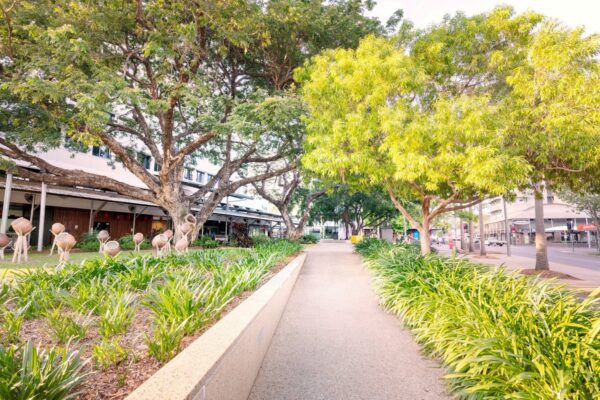Urban Living Labs enable greener, smarter, cleaner cities
New opportunities to demonstrate smarter, greener and cleaner cities are emerging through the ‘COVID reset’ and CSIRO’s first Urban Living Lab – a collaboration with developer, Celestino in Sydney Science Park west of the Sydney.
Temperatures in Western Sydney have intensified with recent hotter summers and Penrith City Council and other local government agencies engaging with CSIRO and Sydney Science Park to understand how urban greening can help mitigate this.
CSIRO Researcher Dr Simon Toze says, “We’ve measured a 5 to 8 degree difference between sensors under trees and those outside, in the sun. There’s also growing evidence that urban greening is good for our physical and mental health.
“But trees need water and nutrients. How we manage the need for water – for people, the environment, for growing trees, for everything else we need – is going to become critical.
“We can find much smarter ways of using water using AI (artificial intelligence). We could recover nutrients or other material from waste and put those back into trees and other infrastructure – a circular economy.
“Some of the waste can go to energy, not just combustion energy, but producing hydrogen.
“So you get this whole integrated approach – that’s where we’re hoping to start to take things. With COVID, we’re at that crossroads, where things like this can happen.”
Dr Toze hopes the COVID reset will include renewed interest in AI within the home, especially for managing appliance and energy use, not just for energy savings in the home, but to balance out peak loads in the grid.
“But people will need to see the social and the economic benefits first. That’s what we want the Urban Living Labs to demonstrate.”
Walkable neighbourhoods
Dr Toze also hopes to see fewer cars in post-COVID cities, from better design that brings home, work and services within walking or cycling distance for everyone – the ‘20- and 30-minute neighbourhoods’.
“We could start to change the structure and function of roads so they become greener and the road surface more porous. You’d have children able to play on the streets again.
“Another thing we’re looking at is the idea of community gardens. There are so many benefits, to do with health, exercise, food security, social capital, and so on. We hope to study it from an energy–water–circular economy perspective, involving citizen science.
“We’re fortunate with Sydney Science Park because it’s just starting to develop. We’re in the process of looking at what can we put into buildings – what technologies are already commercially available and others that are still not commercially available but are close to market.
“That includes CSIRO’s printable solar cells and its GraphAir water purification system. Good quality water is a step towards producing hydrogen.
“So we can plan, from the ground up, smart water systems, smart [hydrogen-based] energy systems, virtual power plants and so on. It will all be designed as part of the infrastructure.
“COVID is showing us a different way to move forward.
“One of the interesting things we’ve seen during the shutdown is how quickly the air quality has improved in a lot of cities around the world. There are cities in India where locals can see the Himalayas again after 40-50 years.
“To me this is proof that change is possible.”
* This week’s blog is an extract of the CSIRO Ecos article by Mary-Lou Considine.
 |
In the face of climate change and heat waves, the Darwin Living Lab looks to create a thriving, cooler tropical capital. (Image: Louise Denton) |
 |
Smart hydrogen based energy systems, smart water systems and virtual power plants will all be part of the infrastructure in future cities. |
